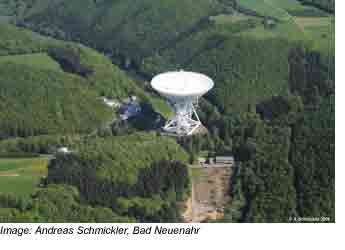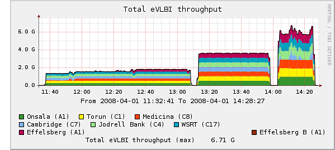News / Press Releases
Effelsberg Joins the e-EVN
Printer-friendly version
 DWINGELOO, The Netherlands (9 April 2008) - On 1 April 2008, Express Production Real-time e-VLBI Service (EXPReS) conducted the first real-time electronic Very Long Baseline Interferometry (e-VLBI) observation to include the 100 meter telescope at Effelsberg, Germany. Effelsberg joins regular e-VLBI participants from the European VLBI Network (e-EVN): Cambridge and Jodrell Bank (UK), Medicina (Italy), Onsala (Sweden), Torun (Poland) and Westerbork (the Netherlands).
DWINGELOO, The Netherlands (9 April 2008) - On 1 April 2008, Express Production Real-time e-VLBI Service (EXPReS) conducted the first real-time electronic Very Long Baseline Interferometry (e-VLBI) observation to include the 100 meter telescope at Effelsberg, Germany. Effelsberg joins regular e-VLBI participants from the European VLBI Network (e-EVN): Cambridge and Jodrell Bank (UK), Medicina (Italy), Onsala (Sweden), Torun (Poland) and Westerbork (the Netherlands).
Data from Effelsberg was transferred electronically at approximately 1 Gbps to the central data correlator at JIVE, the Joint Institute for VLBI in Europe, resulting in a record-breaking total throughput of 6.71 Gbps from all seven stations. The data transfer from Effelsberg is credited in large part to 42 km of new optical fibre from Effelsberg to Bonn, funded by the Max-Planck-Society. From Bonn the data was sent via DFN, GEANT2 and SURFnet to JIVE in the Netherlands.
 JIVE Director Huib Jan van Langevelde was delighted with the successful addition of the Effelsberg telescope to the real-time capabilities of the European VLBI Network. "With the addition of the big 100-m Effelsberg telescope, the e-EVN is not only the fastest VLBI network in the world, but also as sensitive as the EVN for detecting the faintest cosmological sources, especially now that we are reaching 1 Gbps data rates."
JIVE Director Huib Jan van Langevelde was delighted with the successful addition of the Effelsberg telescope to the real-time capabilities of the European VLBI Network. "With the addition of the big 100-m Effelsberg telescope, the e-EVN is not only the fastest VLBI network in the world, but also as sensitive as the EVN for detecting the faintest cosmological sources, especially now that we are reaching 1 Gbps data rates."
Anton Zensus, Director at the Max Planck Institute for Radio Astronomy in Bonn and Chairman of the JIVE Board, congratulated the German team that implemented the dedicated high-speed data link for this purpose. "With the support of the Max-Planck-Society and the EU-funded EXPReS program, we are now, through the participation of the Effelsberg telescope, able to vastly expand the sensitivity of the nascent e-VLBI service."
e-VLBI is a technique by which remotely located radio telescopes observe the same region of sky simultaneously, and data from each telescope are sampled and sent to a central processor via high-speed communication networks operating in real-time. This central data processor, a purpose-built supercomputer, decodes, aligns and correlates the data for every possible telescope combination and can generate images of cosmic radio sources with up to a hundred times better resolution than images from the best optical telescopes. EXPReS is developing e-VLBI to replace traditional VLBI's reliance on storing data on high-capacity disk arrays which are shipped to the correlator. Electronic, real-time VLBI eliminates the shipping of disks and provides astronomers with correlated data in a timely fashion, allowing them to exploit transient astronomical events called Targets of Opportunity.
About EXPReS
Express Production Real-time e-VLBI Service (EXPReS) is a three-year project funded by the European Commission with the objective of creating a distributed, large-scale astronomical instrument of continental and intercontinental dimensions. This electronic Very Long Baseline Interferometer (e-VLBI) is achieved using high-speed communication networks operating in real-time and connecting together some of the largest and most sensitive radio telescopes on the planet. EXPReS is comprised of 19 radio astronomy institutes and national research networks in 14 countries and is coordinated by JIVE, the Joint Institute for VLBI in Europe.
About JIVE
The Joint Institute for VLBI in Europe (JIVE) is a scientific foundation with a mandate to support the operations of the European VLBI Network (EVN). The major activity has been the development, construction and successful operation of the EVN Data Processor, a powerful supercomputer that combines the signals from radio telescopes located across the planet, creating a single virtual telescope of intercontinental dimensions. Using this technique of Very Long Baseline Interferometry (VLBI), astronomers can make detailed images of cosmic radio sources, providing astronomers with the clearest, highest resolution view of some of the most distant and energetic objects in the Universe.
About the Radio Telescope Effelsberg
With a diameter of 100 meters, the Radio Telescope Effelsberg is one of the largest fully steerable radio telescopes on earth. Since operations started in 1972, the technology has been continually improved, making it one of the most advanced modern telescopes worldwide. It is operated by the Max Planck Institute for Radio Astronomy in Bonn, Germany.
# # #
Arpad Szomoru, Head of Data Processor Research and Development
Express Production Real-time e-VLBI Service (EXPReS)
Joint Institute for VLBI in Europe
+31 521 596 509
szomoru@jive.nl
www.expres-eu.org
Kristine Yun, Public Outreach Officer
Express Production Real-time e-VLBI Service (EXPReS)
Joint Institute for VLBI in Europe
+31 521 596 500
kyun@jive.nl
www.expres-eu.org